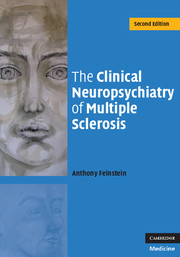Book contents
- Frontmatter
- Contents
- Acknowledgement
- Foreword
- 1 Multiple sclerosis: diagnosis and definitions
- 2 Depression: prevalence, symptoms, diagnosis and clinical correlates
- 3 Depression: etiology and treatment
- 4 Multiple sclerosis, bipolar affective disorder and euphoria
- 5 Multiple sclerosis and pseudobulbar affect
- 6 Multiple sclerosis and psychosis
- 7 Cognitive impairment in multiple sclerosis
- 8 The natural history of cognitive change in multiple sclerosis
- 9 Cognitive impairment in multiple sclerosis: detection, management and significance
- 10 Neuroimaging correlates of cognitive dysfunction
- 11 Multiple sclerosis, disease-modifying treatments and behavioral change
- 12 Multiple sclerosis: a subcortical, white matter dementia?
- Index
- Plate section
- References
2 - Depression: prevalence, symptoms, diagnosis and clinical correlates
Published online by Cambridge University Press: 13 August 2009
- Frontmatter
- Contents
- Acknowledgement
- Foreword
- 1 Multiple sclerosis: diagnosis and definitions
- 2 Depression: prevalence, symptoms, diagnosis and clinical correlates
- 3 Depression: etiology and treatment
- 4 Multiple sclerosis, bipolar affective disorder and euphoria
- 5 Multiple sclerosis and pseudobulbar affect
- 6 Multiple sclerosis and psychosis
- 7 Cognitive impairment in multiple sclerosis
- 8 The natural history of cognitive change in multiple sclerosis
- 9 Cognitive impairment in multiple sclerosis: detection, management and significance
- 10 Neuroimaging correlates of cognitive dysfunction
- 11 Multiple sclerosis, disease-modifying treatments and behavioral change
- 12 Multiple sclerosis: a subcortical, white matter dementia?
- Index
- Plate section
- References
Summary
The observation that depression is part of the clinical picture of MS can be traced back to the case reports of Charcot (1877). Of all the mental state changes associated with MS, depression in various forms is by far the most common. Consequently, it is important that the clinician has a good understanding of how the syndrome may present, what factors may underlie causation and how best to approach treatment. Depression is associated with a considerable morbidity, with evidence suggesting it may be the single biggest factor influencing quality of life for MS patients (Lobentanz et al., 2004; Benedict et al., 2005). Moreover, the link between depression and suicide, so often described in a general psychiatric setting, is equally applicable to the MS clinic. Missing the diagnosis, therefore, does patients a grave disservice. The good news, however, is that depression can often be successfully treated. For all these reasons, a higher profile for this particular aspect of MS is long overdue.
Conceptual issues
The term depression is often loosely applied to describe either a symptom or syndromes of varying severity, with the spectrum including transient changes in mood, adjustment disorders to life events, dysthymia and major depression with or without psychotic features. Common to all is the cardinal feature of low mood.
A decade back the taxonomy underwent a major revision, with the fourth edition of the Diagnostic and Statistical Manual (DSM-IV) (American Psychiatric Association, 1994) dropping the term “organic mood disorder” and replacing it with the category “Mood disorder due to a general medical condition;” of which four subtypes are specified (Table 2.1).
- Type
- Chapter
- Information
- The Clinical Neuropsychiatry of Multiple Sclerosis , pp. 28 - 45Publisher: Cambridge University PressPrint publication year: 2007



